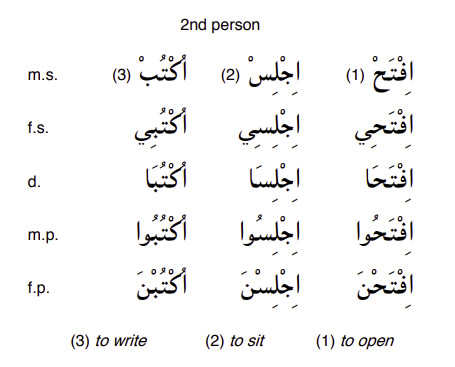Difference between revisions of "Language/Standard-arabic/Grammar/THE-IMPERATIVE"
< Language | Standard-arabic | Grammar
Jump to navigation
Jump to search
(Created page with "thumb <div style="font-size:300%;"> THE IMPERATIVE in Arabic</div> The imperative is formed from the jussive but, since it begins wi...") |
m (Quick edit) |
||
| (2 intermediate revisions by 2 users not shown) | |||
| Line 1: | Line 1: | ||
[[File:Arabic-Language-PolyglotClub.png|thumb]] | [[File:Arabic-Language-PolyglotClub.png|thumb]] | ||
<div | <div class="pg_page_title"> THE IMPERATIVE in Arabic</div> | ||
The imperative is formed from the jussive but, since it begins with two consonants, it takes a short prosthetic vowel. In the triliteral verb, the prosthetic "alif, when the second radical takes fatha or kasra, the vowrl is kasra, when it takes damma, it is damma, as the following table shows: | The imperative is formed from the jussive but, since it begins with two consonants, it takes a short prosthetic vowel. In the triliteral verb, the prosthetic "alif, when the second radical takes fatha or kasra, the vowrl is kasra, when it takes damma, it is damma, as the following table shows: | ||
[[File:Arabic-Language-Imperative-PolyglotClub.jpg]] | |||
<span link>Once you've mastered this lesson, take a look at these related pages:</span> [[Language/Standard-arabic/Grammar/Future-Tense|Future Tense]], [[Language/Standard-arabic/Grammar/Present-tense-conjugation|Standard Arabic Grammar → Verbs and conjugation in Arabic ...]], [[Language/Standard-arabic/Grammar/How-to-Use-Have|How to Use Have]] & [[Language/Standard-arabic/Grammar/NOMINATIVE-SEPARATE-PERSONAL-PRONOUNS|NOMINATIVE SEPARATE PERSONAL PRONOUNS]]. | |||
==Sources== | ==Sources== | ||
http://anacereddine.com/Arabic_Grammar___Exercises.PDF | http://anacereddine.com/Arabic_Grammar___Exercises.PDF | ||
==Other Lessons== | |||
* [[Language/Standard-arabic/Grammar/Negations|Negations]] | |||
* [[Language/Standard-arabic/Grammar/Conditional-Mood|Conditional Mood]] | |||
* [[Language/Standard-arabic/Grammar/RELATIVE-PRONOUNS|RELATIVE PRONOUNS]] | |||
* [[Language/Standard-arabic/Grammar/DEMONSTRATIVE-PRONOUNS|DEMONSTRATIVE PRONOUNS]] | |||
* [[Language/Standard-arabic/Grammar/THE-USE-OF-THE-AFFIXED-PERSONAL-PRONOUNS|THE USE OF THE AFFIXED PERSONAL PRONOUNS]] | |||
* [[Language/Standard-arabic/Grammar/Conjugation-of-the-verb-to-write-in-the-perfect|Conjugation of the verb to write in the perfect]] | |||
* [[Language/Standard-arabic/Grammar/Apologies|Apologies]] | |||
* [[Language/Standard-arabic/Grammar/AFFIXED-PERSONAL-PRONOUNS|AFFIXED PERSONAL PRONOUNS]] | |||
* [[Language/Standard-arabic/Grammar/Negation|Negation]] | |||
* [[Language/Standard-arabic/Grammar/THE-PERFECT|THE PERFECT]] | |||
<span links></span> | |||
Latest revision as of 13:10, 27 March 2023
THE IMPERATIVE in Arabic
The imperative is formed from the jussive but, since it begins with two consonants, it takes a short prosthetic vowel. In the triliteral verb, the prosthetic "alif, when the second radical takes fatha or kasra, the vowrl is kasra, when it takes damma, it is damma, as the following table shows:
Once you've mastered this lesson, take a look at these related pages: Future Tense, Standard Arabic Grammar → Verbs and conjugation in Arabic ..., How to Use Have & NOMINATIVE SEPARATE PERSONAL PRONOUNS.
Sources[edit | edit source]
http://anacereddine.com/Arabic_Grammar___Exercises.PDF
Other Lessons[edit | edit source]
- Negations
- Conditional Mood
- RELATIVE PRONOUNS
- DEMONSTRATIVE PRONOUNS
- THE USE OF THE AFFIXED PERSONAL PRONOUNS
- Conjugation of the verb to write in the perfect
- Apologies
- AFFIXED PERSONAL PRONOUNS
- Negation
- THE PERFECT

